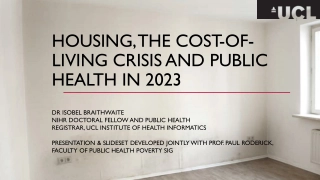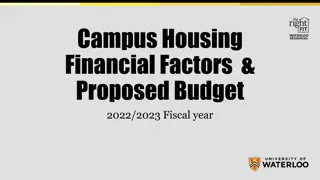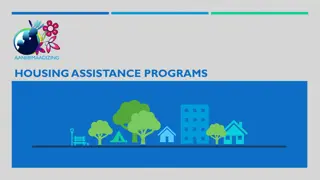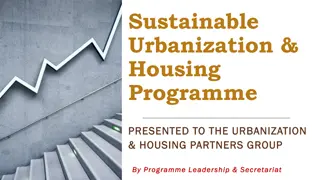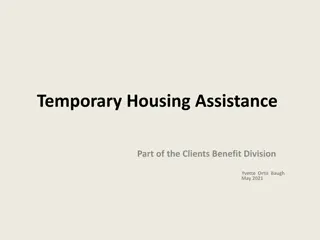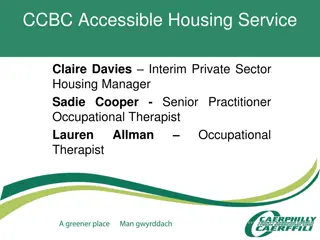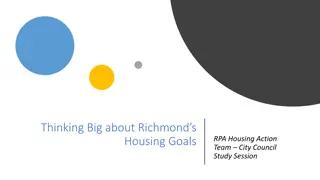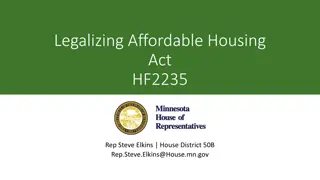Objectively assessed need and housing targets
Objectively assessed housing need is a central aspect of planning, yet the concept lacks a clear definition in official guidelines. This article delves into the complexities of housing need, the constraints faced by planning authorities, and offers pragmatic insights for navigating this challenging terrain.
Download Presentation

Please find below an Image/Link to download the presentation.
The content on the website is provided AS IS for your information and personal use only. It may not be sold, licensed, or shared on other websites without obtaining consent from the author.If you encounter any issues during the download, it is possible that the publisher has removed the file from their server.
You are allowed to download the files provided on this website for personal or commercial use, subject to the condition that they are used lawfully. All files are the property of their respective owners.
The content on the website is provided AS IS for your information and personal use only. It may not be sold, licensed, or shared on other websites without obtaining consent from the author.
E N D
Presentation Transcript
Objectively assessed need and housing targets PAS Spring Conference March 2015 Cristina Howick Peter Brett Associates LLP
Introduction NPPF says Planning authorities must meet objectively assessed need ( the OAN ) in full For all development including housing Unless they are prevented by supply constraints Recognised in the Statement In which case they should export the need to other places Broadly speaking it s obvious what they re after But in practice it s challenging So here s some advice Based on hard experience Highlights from the PAS advice note Including update coming up Work in progress
We do need (sic) a working definition Objectively assessed housing need is central to planning Yet neither NPPF nor PG tell us what it is Need is a very broad term In PPG3 (see Annex) it meant something else entirely There are endless projection scenarios You can t tell which is the right one Unless you know what you re looking for
A pragmatic definition The housing that households are able to buy or rent Either from their own resources In the market sector Or with assistance from the State In the affordable sector or with subsidy Overall housing need in the PPG The market housing that households want and can afford Plus the affordable and subsidised housing that the State wants and can afford to provide for them AKA demand Unconstrained What would be built if planning did not restrict land supply
Caveats Principle It s not an official definition There isn t one of those The PG says Need is what is likely to be needed It s imperfect of course Can t capture every nuance of the Government s thinking Practice There s no evidence about unconstrained (policy-off) demand Planning has been constraining development since 1947 The best we can do is estimate policy-same ( policy-neutral ) What would happen if the constraint stayed the same That s what projections try to do In theory the OAN can be a range In practice you re better off with a single number PG says it s not an exact science Official projections are festooned with health warnings Inspectors sometimes remember this More often they don t
DEFINE HOUSING MARKET AREA Area profile CLG HOUSEHOLD PROJECTIONS The logical thread Start from demography Then adjust it Need & target aren t the same Separated by the policy line The line is fuzzy Especially in the PG Constraints are below Including policy constraints Including Green Belt We now think affordable is below too ADJUST PROJECTIONS FOR: Demographic inputs - Start from ONS 2012 - Look at UnattributableChange - Consider 'indexed' housing formation Past delivery & market signals Future employment Other local circumstances not captured by past trends Affordable housing need OBJECTIVELY ASSESSED NEED Supply capacity Unmet need from other areas Authorities' policy objectives HOUSING PROVISION TARGET
NPPG and PG The Framework says need should be assessed for HMAs Where market areas cross local authority boundaries Which means almost everywhere What is an HMA? A reasonably self-contained area Both for migration and travel to work PG points to many kinds of data Including migration Aim for typically 70% self-containment ( closure ) Sort of suggests each authority should draw their own HMA Not proportionate and not reasonable? If each authority draws an area centred on itself It will just pull in its nearest neighbours You d get as many HMAs as authorities We need a top-down method That maximises self-containment across the country And centres HMAs on large towns / cities
Drawing the boundary Start from the CURDS research for NHPAU / CLG A rigorous and nationally consistent set of HMAs http://www.ncl.ac.uk/curds/research/defining/NHPAU.htm Or pre-existing partnerships / relationships Such as Leps But don t exclude anyone just because they re not old friends Check the above against the latest data Calculate migration containment Commuting also important If in doubt go for the larger area Excluding places may get you into trouble Also consider related areas round the edge (Everything has edges) They re your most likely trading partners (import or export) But will also have other partners Anyway HMAs often overlap and Inspectors know it
An example Greater Birmingham HMA
No perfect answer Be pragmatic There s a hierarchy of HMAs Degrees of self-containment But we have to draw a line somewhere Go for what s manageable and looks reasonable Don t cut across local authority areas Too complicated and the answer is still imperfect Ideally HMAs and functional economic areas should coincide Makes sense and is massively easier Look beyond the HMA too The Duty to Co-operate doesn t stop at the HMA boundary You may be asked to import need from conurbations far away Take London, Brighton & Hove, Birmingham Looking to export over long distances Maybe indirectly as demand ripples out Whatever you do it s horribly messy And there isn t a single answer
The official demographic projections Two publications ONS sub-national population projections (SNPP) CLG household projections - turn that population into households Net new households measure housing demand / need After small adjustment for vacant and second homes Usually c 3% but more in holiday areas See ONS Table KS401EW Trend-driven Roll forward past demographic trends from different base periods Natural change (births less deaths) Migration Household formation (HRRs, headship rates) By demographic group (age x sex x relationship status) For migration the base period is only five years Makes the official projections very unstable And recent projections lock in the recession Assume no change in non-demographic factors Including impact of economic climate on housing demand
Recent releases 2008-based ONS 2008, CLG 2008 Based on very old information Long before 2011 Census Interim 2011-based ONS 2011, CLG 2011 Now superseded by 2012-based ONS, CLG CLG household projections published 26 Feb 2015 Methodology published 4th March We re still trying to work it out Will put an end to our endless number-crunching? Don t count on it
First time for at least 200 years that household size did not fall between Censuses
Unattributable population change People who were in given places in 2011 but not in 2001 (or vice-versa) But aren t accounted for by estimated births / deaths / migration The national total is 103,700 Balance of larger positives and negatives for different places It s probably unrecorded or misrecorded migration To everyone s surprise ONS / CLG 2012 ignores it Can make a big difference to demographic projections Often in large urban areas What to do about it? I now think leave it out Unless you have good local evidence to the contrary
Building demographic scenarios Start from official projections Consider alternative scenarios to Incorporate latest data The official projections often lag behind Fix any anomalies in the modelling Sense check projected future against the past Look at UPC Test alternative base periods for migration Would 10 years be more typical of the long-term trend? Did unusual things happen in your base period? Model household formation recovering from the recession? Until last week indexed or blended was popular with Inspectors New 2012-based CLG maybe a much better answer
What not to do Derive housing need from nil-migration scenarios The NPPF says the OAN includes migration In some places most population growth is net in-migration Demographic projections roll it forward And in the market sector we can t stop it Richer migrants will displace poorer locals Or from supply-constrained ( dwelling-led ) scenarios Supply constraints are nothing to do with need They bear on the target but not the need NPPF, PG and Inspectors are at one on this Or from old RSS targets Supply-constrained and policy-led Or from previous housing completions The NPPF wants us to build more houses than before
Reading the signals PG:[Household] formation rates may have been suppressed historically by under- supply... The assessment will therefore need to reflect the consequences of past under-delivery. As housing projections do not reflect [past] unmet need, LPAs should take a view based on the available evidence of the extent to which household formation rates are of have been constrained by supply. What evidence? Past delivery Related to past planning Was development restricted by lack of planned supply? Market signals Mainly prices/rents higher or rising faster than normal So how do we OA the N ? Apply uplift to the projection PG doesn t say by how much Inspectors have made a rule of thumb 10% for small problem Suggests 15 or 20% for bigger problem?
Housing completions, April 1996 to March 2012 Source: Wychavon District Council , CLG
What not to do Buy a job forecast Translate the jobs into population into households & houses Assuming fixed commuting ratios Infer number of dwellings needed Why not? The forecast already assumes a given population And implicitly households and dwellings But not the same as you calculate at the end Usually fewer Because the forecaster s jobs-to-population factors are different Especially commuting ratios are not fixed In real life commuting adjusts to supply-demand shifts Objectors have to ask just one question Show us the population figures behind your job forecast please And your numbers go in the bin
A real-life example Experian forecasts 31,000 net new jobs in the plan period They also shows population growth In small print at the bottom 45,000 extra residents Taken from ONS 2010-based projections The planners didn t look at that They calculate that 31,000 new jobs needs 74,000 new residents Hence (say) 32,000 new houses Makes no sense Happens all the time
What to do Look at job forecasts Assuming the correct population As per preferred demographic projection Audit the forecasts Do you believe them? Are they consistent with policy aspirations? Are the commuting implications Credible? Acceptable / policy-friendly? If Yes End of (almost) Make sure employment land policies use the same numbers
What to do continued If No Produce new job numbers(demand) Realistic as well as aspirational Don t get carried away But falling jobs / workforce isn t on either Translate into resident population > housing Not necessarily fixed commuting ratios Work with the forecaster for an intelligent view Understand how their jobs-to-population relationship works The models vary If you don t like the result Reconsider the job number In short Plan for enough housing To support the jobs you are expecting and planning for
A different kind of number The PG (paras 022-029 ) shows how to assess affordable need A separate and different calculation to overall need (the OAN) Affordable need is not a part of the OAN It s a different meaning of need About aspiration / entitlement Moves everyone in unsuitable homes to suitable ones Not limited to what affordable providers can pay for About ought Unlike the OAN and projections They re about is Not all of it is net new homes Includes a backlog of existing households When they leave their unsuitable (for them) homes Other people can move in So affordable need is usually a large number Sometimes larger than the OAN
What to do i. ii. Calculate the OAN as above Estimate how much of it could be new affordable housing Given expected developer s contributions % Assess affordable housing need As per paras 022-029 of the PG Compare (iii) with (ii) Are you meeting enough of the affordable need? If not, consider a higher number Changes the target, not the OAN iii. iv. v. vi.
A bad argument Affordable need as per paras 22-29 is part of the OAN It can t be! It s a different meaning of need (see above) Technically we don t know how to deal with it The demographic projections already include an affordable element Though we can t measure it So if we add the two we d be double-counting But the High Court says otherwise? See Satnam Millenium Ltd v Warrington Borough Council 19 Feb 2015 Dangerous
Another bad argument OAN equals affordable need (paras 22-29) times S106 affordable % Say affordable need is 1,000 dpa and S106 % is 33% Your OAN is 3,000 dpa Even if demographic projections + adjustments say 1,200 dpa This can t be right This is another meaning of need again You d be hugely oversupplying need / demand for market housing Especially in places where the market is weakest (low S106 %) It wouldn t get delivered Smart Inspectors know all this Let s hope judges get it too
What to do Assess supply capacity / constraints Needs armour-plated evidence Consider cross-boundary unmet need Can and should you import? Can you justify exporting some? Consider sustainability and well-being Will your proposed target deliver sustainable settlements? With a healthy age structure? Enough critical mass to support key services? Etc etc Remember the OAN is a minimum It s fine to plan for more housing Don t add the shortfall inherited from the last plan New projections and new plan restart the clock See Zurich Assurance v Winchester
Practical Keep it simple There s no need for 18 scenarios and 250 pages Too many numbers lose sight of the main plot It s about a positive strategy for your area While doing your bit for the larger community
Blue sky What would a better NPPF / PG look like? Sort the larger-than local thing Think again about affordable need Is the answer more and more market housing? Much clearer technical guidance Need v demand What to do about projections Etc etc It s not rocket science Can we learn from European partners? Is France doing something right for once? In 2014 its housebuilding fell below 300,000 For the first time since records began England averages 146,000
Thank you chowick@peterbrett.com


